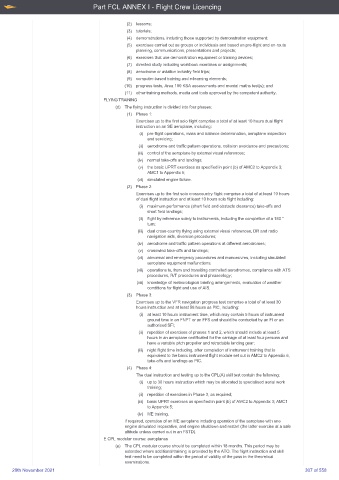Page 307 - UK Aircrew Regulations (Consolidated) 201121
P. 307
Part FCL ANNEX I - Flight Crew Licencing
(2) lessons;
(3) tutorials;
(4) demonstrations, including those supported by demonstration equipment;
(5) exercises carried out as groups or individuals and based on pre-flight and en-route
planning, communications, presentations and projects;
(6) exercises that use demonstration equipment or training devices;
(7) directed study including workbook exercises or assignments;
(8) aerodrome or aviation industry field trips;
(9) computer-based training and e-learning elements;
(10) progress tests, Area 100 KSA assessments and mental maths test(s); and
(11) other training methods, media and tools approved by the competent authority.
FLYING TRAINING
(d) The flying instruction is divided into four phases:
(1) Phase 1:
Exercises up to the first solo flight comprise a total of at least 10 hours dual flight
instruction on an SE aeroplane, including:
(i) pre-flight operations, mass and balance determination, aeroplane inspection
and servicing;
(ii) aerodrome and traffic pattern operations, collision avoidance and precautions;
(iii) control of the aeroplane by external visual references;
(iv) normal take-offs and landings;
(v) the basic UPRT exercises as specified in point (b) of AMC2 to Appendix 3;
AMC1 to Appendix 5;
(vi) simulated engine failure.
(2) Phase 2:
Exercises up to the first solo crosscountry flight comprise a total of at least 10 hours
of dual flight instruction and at least 10 hours solo flight including:
(i) maximum performance (short field and obstacle clearance) take-offs and
short field landings;
(ii) flight by reference solely to instruments, including the completion of a 180 °
turn;
(iii) dual cross-country flying using external visual references, DR and radio
navigation aids, diversion procedures;
(iv) aerodrome and traffic pattern operations at different aerodromes;
(v) crosswind take-offs and landings;
(vi) abnormal and emergency procedures and manoeuvres, including simulated
aeroplane equipment malfunctions;
(vii) operations to, from and transiting controlled aerodromes, compliance with ATS
procedures, R/T procedures and phraseology;
(vii) knowledge of meteorological briefing arrangements, evaluation of weather
conditions for flight and use of AIS.
(3) Phase 3:
Exercises up to the VFR navigation progress test comprise a total of at least 30
hours instruction and at least 58 hours as PIC, including:
(i) at least 10 hours instrument time, which may contain 5 hours of instrument
ground time in an FNPT or an FFS and should be conducted by an FI or an
authorised SFI;
(ii) repetition of exercises of phases 1 and 2, which should include at least 5
hours in an aeroplane certificated for the carriage of at least four persons and
have a variable pitch propeller and retractable landing gear;
(iii) night flight time including, after completion of instrument training that is
equivalent to the basic instrument flight module set out in AMC2 to Appendix 6,
take-offs and landings as PIC.
(4) Phase 4:
The dual instruction and testing up to the CPL(A) skill test contain the following:
(i) up to 30 hours instruction which may be allocated to specialised aerial work
training;
(ii) repetition of exercises in Phase 3, as required;
(iii) basic UPRT exercises as specified in point (b) of AMC2 to Appendix 3; AMC1
to Appendix 5;
(iv) ME training.
If required, operation of an ME aeroplane including operation of the aeroplane with one
engine simulated inoperative, and engine shutdown and restart (the latter exercise at a safe
altitude unless carried out in an FSTD).
E CPL modular course: aeroplanes
(a) The CPL modular course should be completed within 18 months. This period may be
extended where additional training is provided by the ATO. The flight instruction and skill
test need to be completed within the period of validity of the pass in the theoretical
examinations.
20th November 2021 307 of 558

